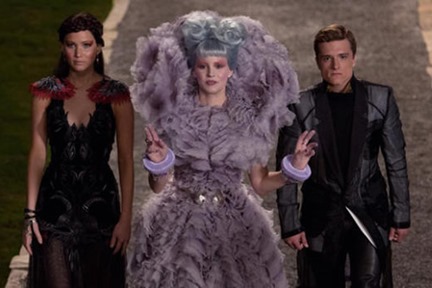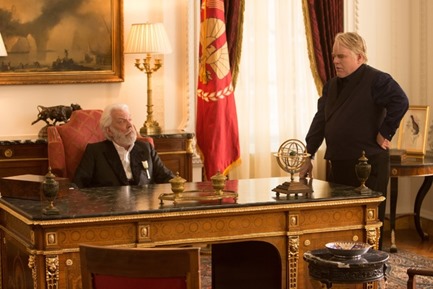The Hunger Games: Catching Fire adapts the second book in the Hunger Games Trilogy into a fast-paced, character driven film with action and suspense to spare. Being taken from the second book in the trilogy, however, it ends at what would – in any other movie series – seem like a very odd place.
Catching Fire has a very specific purpose: like the book, it track Katniss Everdeen’s (Jennifer Lawrence) life from just before the moment she realizes she’s inadvertently become a symbol of hope and resistance to the people of the Twelve districts, to the moment she accepts it. From her last moments of peace in District to the last frame of movie, everything that happens in Catching Fire is about that journey.
As a result, even more than The Hunger Games, Catching Fire demands more of Jennifer Lawrence than most franchise movies require of their casts. Despite her physical skills and courage, Catching Fire details her loss of innocence in a very real and very melancholy way.
Of course, we also see more in each of the other characters: Peeta (Josh Hutcherson) has learned to play to his audience and is so good at it that he even surprises Haymitch (Woody Harrelson); Haymitch continues to show a facility for diplomacy and pragmatism, as well as growing attachment to his charges; and even Effie’s (Elizabeth Banks) cheerful façade begins to crack.
There are story points that need to be addressed: Katniss and Gale’s (Liam Hemsworth) first kiss; the fleeting mockingjay graffiti; the growing efforts of the Capitol to control through feat – curfews, lashings, killings; the Third Quarter Quell – that pits twenty-four Hunger Games winners against each other; the introduction of key characters – Finnick Odair (Sam Claflin), Beetee (Jeffrey Wright), Wireless (Amanda Plummer), Johanna Mason (Jena Malone) and Plutarch Heavensbee (Philip Seymour Hall) among them); and the continued silky evil of President Snow (Donald Sutherland) – and his first overt show of fear…
The script, by Simon Beaufoy and Michael Arndt, hit all the major plot points that required and – and this is important because so many movies based on young adult books series don’t seem to get it – supplies sufficient connective tissue that we never feel lost. They know the characters and give their cast plenty to work with.
Francis Lawrence directs with muscle and nuance – the action in the new arena is intense, but there’s drama in small moments, too – as when Effie’s voice catches for the first time, showing her awareness that things are going wrong. And the final scene is as close to a perfect silent moment as I’ve ever seen.
As good as the cast is, this is Jennifer Lawrence’s movie from first frame to last. She makes us believe that Katniss has no idea how important she’s becoming, just as she makes us believe her shift through fear, loss, pain, rage and finally acceptance with an absolute minimum of facial expression in the movie’s closing moments.
Roger Ebert once noted, no great movie is ever too long and no bad movie is ever short enough. I know that Catching Fire is two-and-a-half hours long, but it never feels like it. As Catching Fire is that rare second in a series that equals or betters its original – an amazing accomplishment given that it’s the middle of the story and neither has a true beginning nor a true ending.
Final Grade: A

